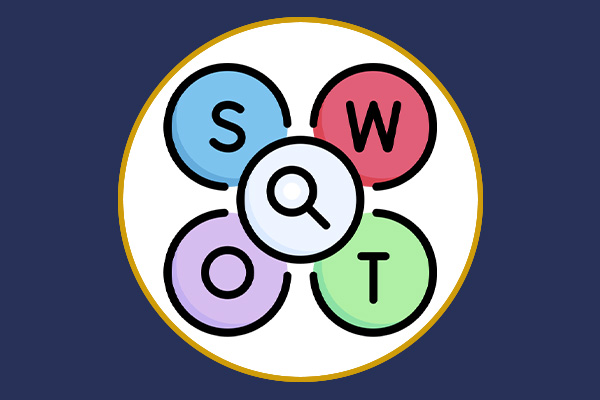Home >> Blog >> What is SWOT Analysis?
What is SWOT Analysis?

Table of Contents
1. Introduction
It's not simple to run a business. While running a business, you must make tough decisions daily, and they are part of your business. Some decisions are fruitful, and some decisions prove to be a huge mistake for your business. In such a situation, many aspects should be taken care of before making any decision because one wrong decision can prove costly for your business.
Many of you question how to develop the art of making accurate decisions. Is there any technique for this? So the answer is yes. There is a technique called SWOT Analysis, with the help of which you can develop a full-proof decision-making method.
For your information, SWOT analysis is used by large companies. SWOT analysis has been an excellent tool for businesses that want to evaluate internal and external factors and implement a strategy for the growth of their business. So let's jump into the SWOT analysis technique in this blog today and try to understand what SWOT analysis is and how you can apply SWOT analysis for your business growth and success. Keep reading.
2. What Is SWOT Analysis?
SWOT analysis is a powerful strategic planning technique that most businesses use. However, it can also be used by individuals and entities. Businesses use this powerful tool to evaluate their competitors' positions and develop a strategic plan. Here SWOT stands for Strengths, Weaknesses, Opportunities, and Threats. Thus the SWOT analysis of a business is a method of evaluating and relying on these four aspects. In SWOT analysis, where strengths and weaknesses indicate "internal" factors, opportunities and threats indicate "external" factors; that is, those outside aren't in control of an individual or company. By doing a SWOT analysis, you can uncover the areas of your business that hold you back. And if you cannot protect the flaws of your business in time, it may be exploited by your competitors.
Talking about the history of SWOT analysis, the credit for its framework is attributed to Albert Humphrey. Albert Humphrey was a management consultant and tested the method at the Stanford Research Institute in the 1960s and 1970s. He succeeded in this test and introduced this method to the world.
The SWOT analysis used data from Fortune 500 companies, and the organization is still testing innovations to improve it. Nevertheless, there is no doubt that SWOT analysis can be an essential tool in planning and making the right decision for your business, as it helps uncover the potential threats of a business and hidden opportunities. So often, these small things go unnoticed, but they play a vital role in moving your business forward or backwards.
3. Why Is SWOT Analysis Important?
SWOT analysis shows you the way to improve your business performance. It also helps uncover the organization's dangerous blindspots and challenge risky assumptions. Trust me, if you use this tool carefully and collaboratively, it can share great insights about your business – for example, where your business is in the market now and how it can grow.
SWOT lets you share insights into your business's competitors so you know where to improve. For example, if you are only aware of your organization's strengths, you can assume that your business is the best and can grow. But this is not true. Instead, you need to identify your business strengths, weaknesses, and threats. If you recognize these two aspects of your business, no one can stop your business from moving forward.
In business, sometimes everything looks right from the inside and outside, yet your business is not growing; by doing a SWOT analysis, you can identify the mistakes of your business. But, on the other hand, by ignoring SWOT analysis, you do not take your business very far.
4. How To Conduct A SWOT Analysis?
As you know, a SWOT analysis of a company helps you to identify its strengths and highlight its weaknesses. However, you can take your business to a different level by identifying opportunities and threats. So let us now understand how to do a SWOT analysis.
First of all, understand that SWOT analysis is easy and if you already have any confusion about it, then remove it. SWOT analysis is similar to having brainstorming sessions with your team. Therefore brainstorming in SWOT analysis should not take more than a few hours. Gather all the decision makers keeping in mind all the aspects of your business, and start the process. But remember that you should have people associated with all the business departments; then, only this brainstorming process will be successful. By having people from all departments, you will get different perspectives about your business, and you can take their opinion to grow your business.
Below is an image of a SWOT analysis matrix. As you can see, it is a 2×2 grid in which a square is divided into four parts for the four aspects of the SWOT. Next, hand out a notepad and a pen to all the shareholders and colleagues in the meeting and ask them to think individually for each of the four parts, identify the points, and write them in that box, which means that each box will have its name – Strength, Weakness, Opportunity, and Threat. They must write these aspects in the right part of the matrix, keeping their business in mind.
5. The Internal And External Factors Of SWOT Analysis
As we told you above, internal and external factors play a crucial role in any business. The strengths and weaknesses of any organization are considered internal factors. At the same time, opportunity and threat are considered external factors. Strengths and weaknesses are considered internal factors because you, your team, or your department control them. In contrast, opportunities and threats are considered external factors because the company has no control over them.
To understand SWOT analysis properly and successfully, one must understand its four aspects.
5.1 Strength
The first quadrant includes the strengths of your organization. That is to say, what is the USP of your business which makes it different from other businesses? Knowing your company's strengths is essential since you can only develop the appropriate strategy to compete with your rivals. Your business's strength can be a strong brand presence, great leadership, proprietary technology, a unique manufacturing process, or even greater profits.
Since strength in a business is an internal factor, it is within the organization's control. Therefore, in the strength section, include only those items you have a better hold on than your competitors.
5.2 Weaknesses
The second quadrant includes weaknesses; identifying your weaknesses is very important for a business. Often organizations find it challenging to do so because they believe their business is the best and has no weaknesses. Usually, the businesses that follow such a belief are left behind in the long race. Everyone loves their business, but that doesn't mean hiding the weaknesses of your business. If you recognize the weaknesses of your business once, it will only hurt you for a short time, but it will give you many positive results in the years to come. Try to be honest when listing your weaknesses.
Weaknesses are also factors internal to your organization, including the organization's employees, culture, processes, systems, resources, etc. As well as employee morale, supply chain issues, cash flow problems, distraction, and burn rate can be included.
5.3 Opportunities
In the third quadrant, the third Aspect opportunity of SWOT is included. Again, it is an external factor, and the organization does not have control over it. However, if the organization manages it properly, it can give an edge to the business.
Opportunity improves the future of your organization. Opportunities may include future contracts and partners, the latest technological advancements, favorable government policies, new products, markets, etc.
The opportunity helps you to know how even a small step can give you an edge over your competitors. Therefore, it is important to note down every future scenario; only then can you think about your business's growth. Also, remember that just listing the opportunities will not change anything in your business unless you implement them in the future.
5.4 Threats
The threat is included in the last quadrant of the SWOT matrix. It is also an external factor of the business and can affect your business negatively. Threats associated with your business may include the entry of a new competitor into the market, environmental factors, supply chain issues, legislative influence, dry jobs market, etc.
Talking about the most crucial component of SWOT analysis is risk listing. If you think carefully about it and identify the business's hazards, you can take your business to new heights.
6. Limitations Of SWOT Analysis
SWOT analysis has many features, but it also has some limitations. Sometimes this greatly simplifies the organizations' circumstances, leading to overlooking some important strategies. For example, markets are always volatile and uncertain, so categorizing aspects such as strengths, weaknesses, opportunities, and threats can be very subjective. Another restriction of SWOT analysis is that it emphasizes the importance of four aspects of a business but does not explain how an organization can identify these aspects.
Some of the limitations of SWOT analysis include the following-
-
Bad industrial relations.
-
Price hike.
-
Government law.
-
Raw material.
-
The economic environment.
-
Shortage of skilled labor.
-
Inadequate research and development facilities.
7. Bottom Line
SWOT analysis can prove to be very fruitful for your business. SWOT analysis can help you formulate the ultimate strategy for your business. Aspects identified from SWOT analysis, i.e., double your strengths, work on your weaknesses, don't miss out on your opportunities, and make the most of opportunities. Also, reduce the risks associated with your business.
Frequently Asked Questions
SWOT stands for Strengths, Weaknesses, Opportunities, and Threats.
SWOT analysis shows your business performance. It also helps uncover the organization's dangerous blindspots and challenge risky assumptions. If you use this tool carefully and collaboratively, it can share great insights about your business.
Yes, almost every business uses SWOT analysis. It helps to understand the four dimensions of your business.

















